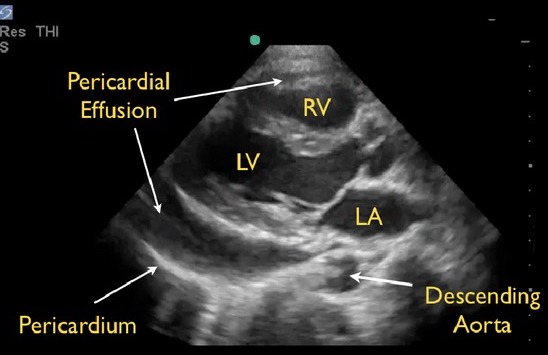Pericardial Effusion
Pericardial Effusion
David Ray Velez, MD
Table of Contents
Introduction
Definition: A Collection of Fluid within the Pericardium Beyond Small Physiologic Amounts (15-50 mL)
Causes
- Idiopathic
- Malignancy
- Uremia
- Iatrogenic
- Traumatic
- Post Myocardial Infarction
- Acute Pericarditis
Presentation
- Most are Asymptomatic if Not Hemodynamically Significant
- Cardiac Tamponade and Hemodynamic Instability
- Chest Pain
- Ewart Sign: Dullness (Woody) to Percussion, Egophony, and Bronchial Breath Sounds at the Inferior Angle of the Left Scapula
- Theoretically Due to Effusion Size Being Large Enough to Compress the Left Lower Lobe of the Lung
- *More of a Historical Interest Due to Low Sensitivity or Specificity
Size
- Rapid Accumulation of Even a Small Amount of Blood is Higher Risk for Collapse – Even Larger Volumes Can Be Well Tolerated if They Accumulate Slowly Over Weeks-Years
| Volume | Thickness on Echocardiogram | |
| Small | < 100 cc | < 10 mm |
| Moderate | 100-500 cc | 10-20 mm |
| Large | > 500 cc | > 20 mm |
Diagnosis
Diagnosis
- Primarily Diagnosed by Echocardiogram
- CT or MRI May Be Useful if Echocardiogram is Non-Diagnostic
EKG Findings
- Sinus Tachycardia
- Low QRS Voltage
- Electrical Alternans – Cyclic Beat-to-Beat Shift in the QRS Axis from Mechanical Swinging of the Heart within a Large Effusion
Echocardiogram Findings
- Dark Hypoechoic Fluid Seen Around the Heart
- Best Seen in the Parasternal Long-Axis or Subcostal View
- *See Point of Care Ultrasound (POCUS)
Differentiate from Pathology with a Similar Appearance
- Pericardial Fat Pad – Usually Located Anteriorly and Will Not Be Completely Anechoic (Pericardial Effusion May Be More Circumferential and More Hypoechoic)
- Pleural Effusion – Will Be Seen Posterior to the Descending Aorta (Pericardial Effusion is Seen Anterior to the Descending Aorta)
Signs of Cardiac Tamponade
- Systolic Right Atrial Collapse – First Sign
- Diastolic Right Ventricular Collapse
- Dilated and Noncollapsible IVC
- “Swinging Heart” with Pendular Motion from Circumferential Fluid Accumulation

Pericardial Effusion on POCUS: Anterior to the Descending Aorta 2

Pleural Effusion on POCUS: Posterior to the Descending Aorta 2
Treatment
Cardiac Tamponade
- Requires Urgent Drainage
- *See Cardiac Tamponade
Pericardial Fluid Drainage
- Indications:
- Cardiac Tamponade or Hemodynamic Instability
- Suspected Purulent Pericarditis (Bacterial or Tuberculosis)
- Suspected Malignant Pericarditis
- Large Chronic (> 3 Months) Idiopathic Effusion of Unknown Etiology for Diagnostic Evaluation
- Symptomatic Moderate-Large Effusion that Fails Medical Therapy
- Approach:
- Pericardiocentesis is Generally Preferred
- Indications for Surgical Median Sternotomy:
- Concerned for Bleeding/Traumatic Injury
- Inaccessible to Pericardiocentesis
- Effusion Small or Loculated
- Need for Biopsy
- Coagulopathic
Medical Management
- Initial Medical Management Alone May Be Appropriate for Even Large Effusions without an Immediate Indication for Drainage
- Monitor with Serial Exams and Echocardiograms Every 5-7 Days
- Avoid Volume Depletion
- Treat Any Underlying Cause
References
- COVER: BruceBlaus. Wikimedia Commons. (License: CC BY-3.0)
- Seif D, Perera P, Mailhot T, Riley D, Mandavia D. Bedside ultrasound in resuscitation and the rapid ultrasound in shock protocol. Crit Care Res Pract. 2012;2012:503254. (License: CC BY-3.0)
